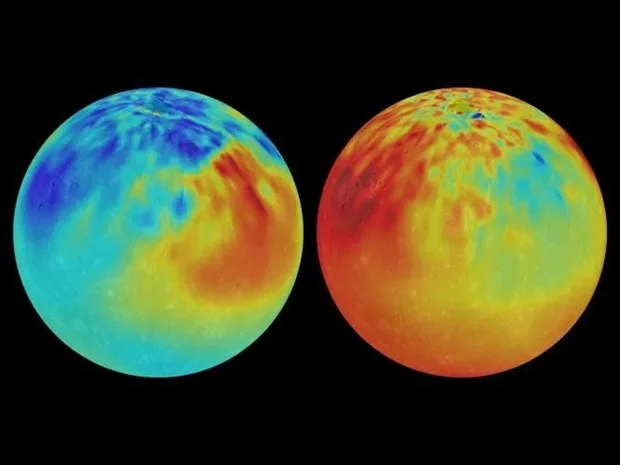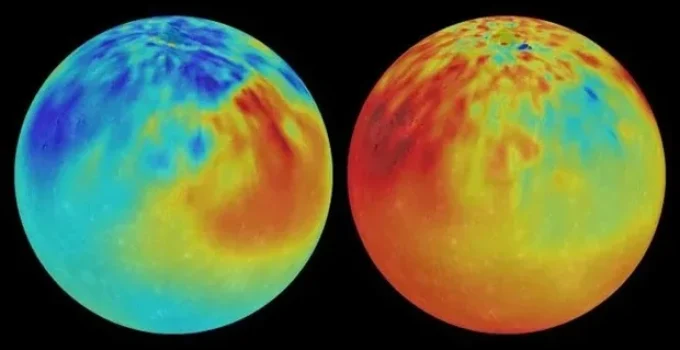Dive Deeper
- Can We Live on Mercury?
- Extreme Temperatures on Mercury
- Mercury Has No Atmosphere
- Radiation and Solar Dangers
- What Would a Mercury Base Need?
- 🎯 Final Thoughts
- 📚 References
Can We Live on Mercury?

Image Credit: NASA/Johns Hopkins University Applied Physics Laboratory/Carnegie Institution of Washington
In science fiction, humans live on all kinds of planets. But what about real life? Could we ever live on Mercury, the planet closest to the Sun?
The short answer is no—not with today’s technology. Mercury is one of the most extreme places in the solar system. It has no breathable air, dangerous radiation, and temperatures that swing from boiling to freezing. Still, some scientists like to explore the idea of living on other planets, even harsh ones like Mercury. Let’s take a closer look at why living there would be so difficult—and what it would take to survive.
Extreme Temperatures on Mercury
Mercury experiences some of the wildest temperatures of any planet.
| Location | Day Temperature | Night Temperature |
|---|---|---|
| Sun-facing side | Up to 800°F (430°C) | |
| Dark side | As low as -290°F (-180°C) |
Because Mercury rotates very slowly and has almost no atmosphere, the Sun-facing side gets extremely hot, while the other side becomes dangerously cold. A full day on Mercury lasts about 176 Earth days, so one side bakes in sunlight for weeks while the other freezes.
📊 Fact: According to NASA, Mercury’s temperature range is the largest of any planet in the solar system [1].
This extreme heating and cooling would make it very difficult for humans to survive without heavy protection and temperature control systems.
Mercury Has No Atmosphere
One of the biggest problems with living on Mercury is that it has no real atmosphere. It only has a super-thin “exosphere,” which:
- Doesn’t hold in heat
- Can’t block radiation
- Has no oxygen to breathe
- Offers no protection from space debris
Without an atmosphere, humans would need to stay inside a sealed habitat—like a space station on the ground. Stepping outside without a space suit would be instantly deadly.
Radiation and Solar Dangers
Because Mercury is so close to the Sun, it gets bombarded with solar radiation. This includes:
- Ultraviolet rays (UV)
- X-rays
- Charged particles from solar wind
On Earth, our atmosphere and magnetic field protect us from these rays. On Mercury, there is no such protection. Humans would need to live underground or inside thick shelters made of special materials to stay safe.
⚠️ Warning: The radiation levels on Mercury could kill a human in minutes without shielding [2].
What Would a Mercury Base Need?
Even though Mercury is dangerous, some scientists have imagined what it would take to build a robotic station or even a tiny research base there. Here’s what would be needed:
- Thick radiation shielding
- Insulation to handle hot and cold temperatures
- Life support systems for oxygen, water, and food
- A power source—possibly solar panels, but they’d have to move to avoid melting
- Underground shelters to avoid the Sun’s heat
Some scientists have suggested that any base on Mercury would have to “chase the twilight”—meaning it would always stay in the part of the planet between day and night. That zone might be the only place with survivable temperatures.
| Challenge | Solution Needed |
|---|---|
| Extreme heat & cold | Smart insulation or mobile shelter |
| No air | Life support with oxygen supply |
| Radiation | Underground or shielded living areas |
| No water | Bring it or mine it from ice in craters |
🎯 Final Thoughts
Mercury is not a good place for human life. It’s too hot, too cold, and too dangerous. There’s no air, no water, and no protection from the Sun’s harmful rays. Even though it’s the closest planet to Earth, it’s one of the least likely places we could ever live.
Still, studying Mercury helps scientists learn about how planets work, especially rocky ones like Earth. Future missions might use robots to explore more safely. For now, Mercury is a place best left to machines—not people.
📚 References
- NASA Solar System Exploration – Mercury Overview: https://solarsystem.nasa.gov/planets/mercury/overview/
- ESA (European Space Agency) – “Could Humans Live on Mercury?” https://www.esa.int/Science_Exploration/Space_Science
- Solomon, S.C., et al. “MESSENGER Mission to Mercury.” Science, vol. 307, 2005.
- BepiColombo Mission – European Space Agency: https://www.esa.int/Science_Exploration/Space_Science/BepiColombo
- Zubrin, R. The Case for Space. Prometheus Books, 2019.
